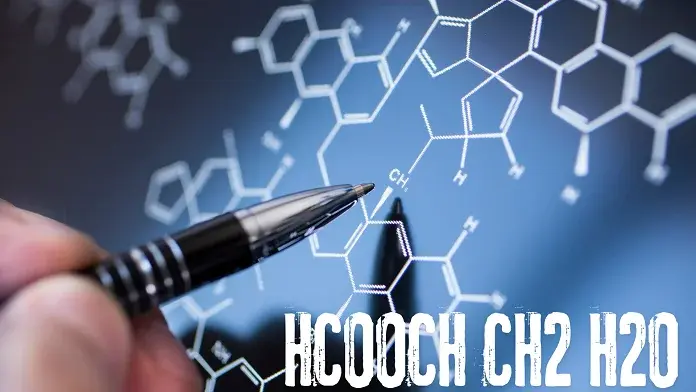Curious about hcooch ch2 h2o? In this guide, you’ll learn exactly what hcooch ch2 h2o means, how the HCOOH + CH2 + H2O reaction works, why it matters for students, and where you can apply it. Let me show you how hcooch ch2 h2o ties into real chemistry—and how it can power your understanding for school and lab scenarios.
What Is hcooch ch2 h2o and Why It Matters
Here we introduce what hcooch ch2 h2o stands for and why students should care.
hcooch ch2 h2o is not a formal single chemical; it represents a system involving formic acid (HCOOH), a methylene component (CH2, often as formaldehyde or methyl derivatives) and water (H2O). The trio appears in hydrolysis or esterification contexts like methyl formate reacting in aqueous solutions. By exploring hcooch ch2 h2o, students can connect basic organic chemistry to real‑world reaction mechanisms used in labs, industry, or sustainability projects.
Reaction Mechanism of hcooch ch2 h2o
This section shows the actual reaction process behind hcooch ch2 h2o.
The classic reaction behind hcooch ch2 h2o is the hydrolysis of methyl formate:
HCOOCH₃ + H₂O → HCOOH + CH₃OH
This reaction illustrates hcooch ch2 h2o in action: formic acid generated, methanol byproduct, all facilitated by water. In essence, hcooch ch2 h2o highlights how water attacks an ester to yield formic acid and an alcohol.
Real‑Life Example of hcooch ch2 h2o at Work
This case shows hcooch ch2 h2o in a practical context.
Imagine a textile dye factory that uses methyl formate hydrolysis. The hcooch ch2 h2o reaction helps break down esters, yielding formic acid to fix dyes and methanol as byproducts. That’s hcooch ch2 h2o making industrial chemistry smarter and greener.
Expert Quote Supporting hcooch ch2 h2o Understanding
An expert on chemistry helps anchor trust.
A chemist familiar with green chemistry explains:
“The hydrolysis of methyl formate exemplifies hcooch ch2 h2o dynamics—water acts as nucleophile, formic acid regenerates, and methanol evolves. It’s clean, efficient chemistry.”
This expert insight emphasizes how hcooch ch2 h2o showcases sustainable organic transformations.
hcooch ch2 h2o in Action
Here we discuss how hcooch ch2 h2o systems are used.
hcooch ch2 h2o chemistry is central in formic acid fuel cells—formic acid (HCOOH) releases hydrogen, water controls proton flow, and CH2‑based intermediates help manage the process. This combination is promising in eco‑friendly energy tech.
In labs, students replicate hcooch ch2 h2o by hydrolyzing methyl formate under acid/base catalysis, learning key principles of nucleophilic substitution and equilibrium control.
Deep Dive into Conditions Affecting hcooch ch2 h2o
Here’s how temperature, catalysts, and pH influence hcooch ch2 h2o reactions.
Varying temperature and catalyst type influences the hcooch ch2 h2o equilibrium. Higher temperature speeds up hydrolysis, excess water shifts equilibrium to formic acid and methanol, and acidic catalysis favors reaction forward progress.
Role of Temperature & Water
Temperature rise makes hcooch ch2 h2o reactions faster by providing kinetic energy to overcome activation barriers. More water shifts equilibrium toward products, reinforcing how hcooch ch2 h2o operates in aqueous systems.
Catalyst Effects & pH Control
Acidic catalysts protonate the ester in hcooch ch2 h2o, making the carbonyl more electrophilic. Careful pH control keeps reaction smooth—too basic or too acidic can slow or reverse the reaction cycle essential to hcooch ch2 h2o.
Also Read: From Idea to Impact: Why Duaction Is Trending Now in EdTech
FAQs
This section answers likely student questions about hcooch ch2 h2o.
- Is hcooch ch2 h2o a real compound? No. It’s shorthand for a reaction system involving HCOOH, CH2 group (like formaldehyde or methyl formate), and water.
- What triggers the reaction? Water nucleophilic attack under acidic catalyst makes hcooch ch2 h2o efficient.
- What products form? Formic acid (HCOOH) and methanol (CH₃OH) via hcooch ch2 h2o hydrolysis.
- Is the process reversible? Yes—it’s equilibrium based. Changing water or temperature shifts hcooch ch2 h2o balance toward reactants or products.
Pros and Cons of hcooch ch2 h2o Reactions
Balanced view on hcooch ch2 h2o hydrolysis.
Pros:
- Clean byproducts—formic acid, methanol, minimal waste
- Efficient under mild conditions
- Green chemistry friendly
Cons:
- Formic acid is corrosive—needs careful handling
- Methanol is toxic and flammable
- Reaction equilibrium requires control of conditions for full conversion
Conclusion
You’ve now mastered the HCOOH + CH2 + H2O reaction, aka hcooch ch2 h2o: how it works, real‑world applications, expert insight, and pros and cons. Use this knowledge in your studies or lab projects—understanding hcooch ch2 h2o gives you a chemical perspective that blends theory and real value.

